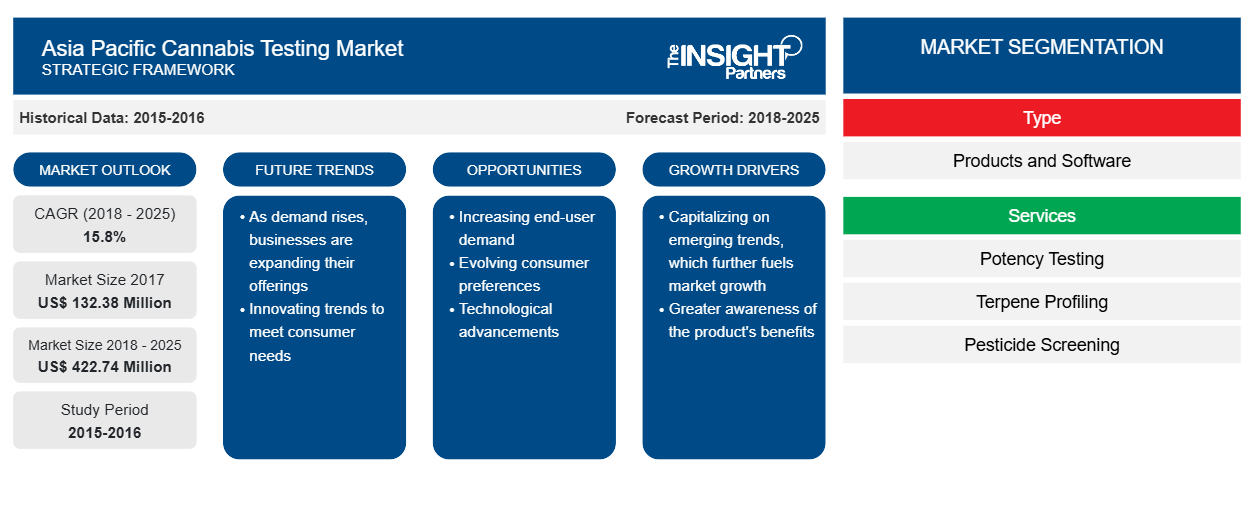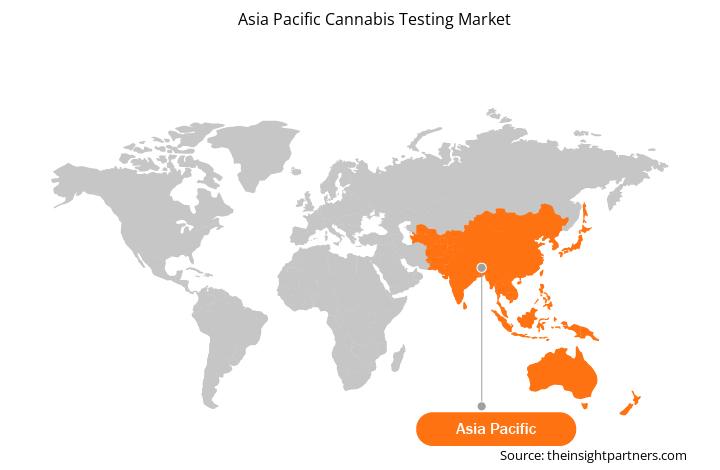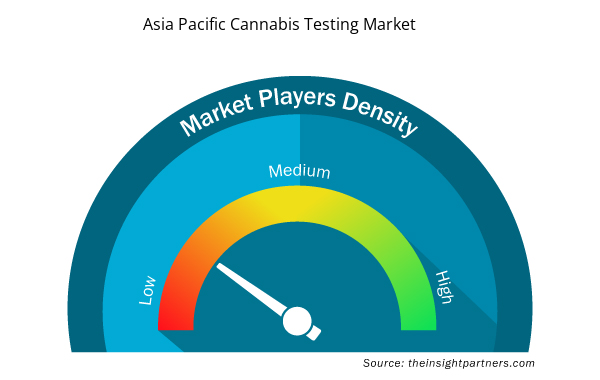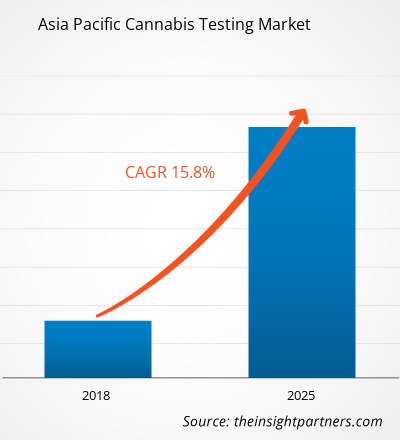The Asia Pacific cannabis testing market accounted to US$ 132.38 Mn in 2017 and is expected to grow at a CAGR of 15.8% during the forecast period 2018 – 2025, to account to US$ 422.74 Mn by 2025.
The Asia Pacific cannabis testing market is expected to grow at highest rate during the forecast period owing to growing adoption of LIMS, and cannabis legalization for medical and recreational purpose in Asia Pacific region.
Lucrative Regional Markets

- This FREE sample will include data analysis, ranging from market trends to estimates and forecasts.
- This FREE sample will include data analysis, ranging from market trends to estimates and forecasts.
Market Insights
Growing adoption of LIMS
The growing advanced technology provide the best solutions to meet the current requirements and enables the system to be readily adapted based on the needs. The modern LIMS (Laboratory Information Management Systems) system are used to automatically registers and archives the results of laboratory work, to support people management & equipment and materials administration. Advancements including, macro level challenges to increase innovation, manage risk, improve governance, comply with regulatory requirements, and deliver quantifiable operational results, help pathology laboratories to meet the evolving demands of the modern pathology services in the region. The increasing adoption of LIMS technique helps to improve the transparency to lab work status, reducing the costs & improved efficiency, providing flexibility to accommodate new requirements and also help to improve quality & compliance. Penetration of information technology and increasing demand for data management and standardization is helping in growing the number of LIMS vendors in the market. The increasing demand for the LIMS in Asian market and R&D spends in the counties like China and India is growing that proportionally upsurge the market growth in the region.
Thus, due to the above advancements, the cannabis testing market is expected to grow at a rapid pace during the forecast period.
Cannabis legalization for medical and recreational purpose
The Asia Pacific region projects a great demand for cannabis testing market. This is because the medical use of cannabis to heal patients of various disease for example chronic neuropathic pain, and any spinal injury. It also helps to deal with anorexia in HIV AIDS which is a major challenge in this region. In December 2018, Thailand was the first country in Southeast Asia to legalize cannabis. There has been significant rise in investments in cannabis testing labs and recent law changes which have led to acceptance of marijuana and cannabis.
Thus, due to growing legalization of cannabis, the cannabis testing market is expected to grow at rapid pace.
Type Insights
In 2017, the product segment held a largest market share of 73.7% of the cannabis testing market, by type. This segment is also expected to dominate the market in 2025 owing diverse portfolio of cannabis testing products to the healthcare industry for innovations in the technologies. Moreover, the same segment is also expected to witness the highest CAGR in the market accounting to 16.1% in 2018 to 2015 owing to increasing analytical services and medicinal cannabis services in testing cannabis.
Service Insights
The Asia Pacific cannabis testing market on the basis of service is segmented into potency testing, microbial analysis, residual solvent screening, heavy metal testing, pesticide screening, terpene profiling, and genetic testing. The potency testing segment is anticipated to grow at a CAGR of 16.9% during the forecast period. Depending on the state in which testing occurs, a sample’s THC and CBD levels, along with its tetrahydrocannabinolic and cannabidolic acids are required. Other labs may opt to test samples for their CBC and CBG as well. Testing for potency involves gas or liquid chromatography for a range of matrices.
End User Insights
The testing laboratory segment held a largest market share of 49.2% of the cannabis testing market, by end user. This segment is also expected to dominate the market in 2025 owing to increasing number of diagnostic testing performed in the reference labs for the numerous diseases.
Cannabis Testing Market, by Type

- This FREE sample will include data analysis, ranging from market trends to estimates and forecasts.
- This FREE sample will include data analysis, ranging from market trends to estimates and forecasts.
Customize This Report To Suit Your Requirement
You will get customization on any report - free of charge - including parts of this report, or country-level analysis, Excel Data pack, as well as avail great offers and discounts for start-ups & universities
Asia Pacific Cannabis Testing Market: Strategic Insights

- Get Top Key Market Trends of this report.This FREE sample will include data analysis, ranging from market trends to estimates and forecasts.
You will get customization on any report - free of charge - including parts of this report, or country-level analysis, Excel Data pack, as well as avail great offers and discounts for start-ups & universities
Asia Pacific Cannabis Testing Market: Strategic Insights

- Get Top Key Market Trends of this report.This FREE sample will include data analysis, ranging from market trends to estimates and forecasts.
Strategic acquisition and product launches were observed as the most adopted strategy in Asia Pacific cannabis testing industry. Few of the recent product launch and product approval are listed below:
2016: Agilent Technologies, Inc. introduced Agilent 5110 ICP-OES that allow scientists to perform faster, more precise ICP-OES analysis.
2017: SCIEX launched the X-Series Quadrupole Time of Flight (QTOF) mass spectrometry (MS) platform, X500B QTOF System.
2018: Restek and Separation Science entered into a collaboration to develop a multi-speaker eSeminar focused on testing methods and associated topics for medicinal cannabis labs.
CANNABIS TESTING – MARKET SEGMENTATION
By Type
- Products
- Software
By Service
- Potency Testing
- Terpene Profiling
- Pesticide Screening
- Residual Solvent Screening
- Heavy Metal Testing
- Microbial Analysis
By End User
- Testing Laboratories
- Drug Manufacturers
- Research Institutes
By Geography
• Asia Pacific
- China
- India
- Japan
Company Profiles
- Agilent Technologies
- PerkinElmer, Inc.
- Shimadzu Corporation
- SCIEX
- Merck KGaA
- Restek Corporation
- Waters
- CannaSafe Analytics
- Accelerated Technology Laboratories, Inc.
- Digipath Labs
Asia Pacific Cannabis Testing Market Regional Insights
The regional trends and factors influencing the Asia Pacific Cannabis Testing Market throughout the forecast period have been thoroughly explained by the analysts at Insight Partners. This section also discusses Asia Pacific Cannabis Testing Market segments and geography across North America, Europe, Asia Pacific, Middle East and Africa, and South and Central America.

- Get the Regional Specific Data for Asia Pacific Cannabis Testing Market
Asia Pacific Cannabis Testing Market Report Scope
| Report Attribute | Details |
|---|---|
| Market size in 2017 | US$ 132.38 Million |
| Market Size by 2025 | US$ 422.74 Million |
| Global CAGR (2018 - 2025) | 15.8% |
| Historical Data | 2015-2016 |
| Forecast period | 2018-2025 |
| Segments Covered |
By Type
|
| Regions and Countries Covered | Asia-Pacific
|
| Market leaders and key company profiles |
Asia Pacific Cannabis Testing Market Players Density: Understanding Its Impact on Business Dynamics
The Asia Pacific Cannabis Testing Market is growing rapidly, driven by increasing end-user demand due to factors such as evolving consumer preferences, technological advancements, and greater awareness of the product's benefits. As demand rises, businesses are expanding their offerings, innovating to meet consumer needs, and capitalizing on emerging trends, which further fuels market growth.
Market players density refers to the distribution of firms or companies operating within a particular market or industry. It indicates how many competitors (market players) are present in a given market space relative to its size or total market value.
Major Companies operating in the Asia Pacific Cannabis Testing Market are:
- Agilent Technologies
- PerkinElmer, Inc.
- Shimadzu Corporation
- SCIEX
- Merck KGaA
Disclaimer: The companies listed above are not ranked in any particular order.

- Get the Asia Pacific Cannabis Testing Market top key players overview
- Historical Analysis (2 Years), Base Year, Forecast (7 Years) with CAGR
- PEST and SWOT Analysis
- Market Size Value / Volume - Global, Regional, Country
- Industry and Competitive Landscape
- Excel Dataset



Report Coverage
Revenue forecast, Company Analysis, Industry landscape, Growth factors, and Trends

Segment Covered
Type, Services, End User and Country

Regional Scope
North America, Europe, Asia Pacific, Middle East & Africa, South & Central America

Country Scope
Australia, China, Japan, South Korea
Trends and growth analysis reports related to Life Sciences : READ MORE..
The List of Companies
1. Agilent Technologies
2. PerkinElmer, Inc.
3. Shimadzu Corporation
4. SCIEX
5. Merck KGaA
6. Restek Corporation
7. Waters
8. CannaSafe Analytics
9. Accelerated Technology Laboratories, Inc.
10. Digipath Labs

 Get Free Sample For
Get Free Sample For